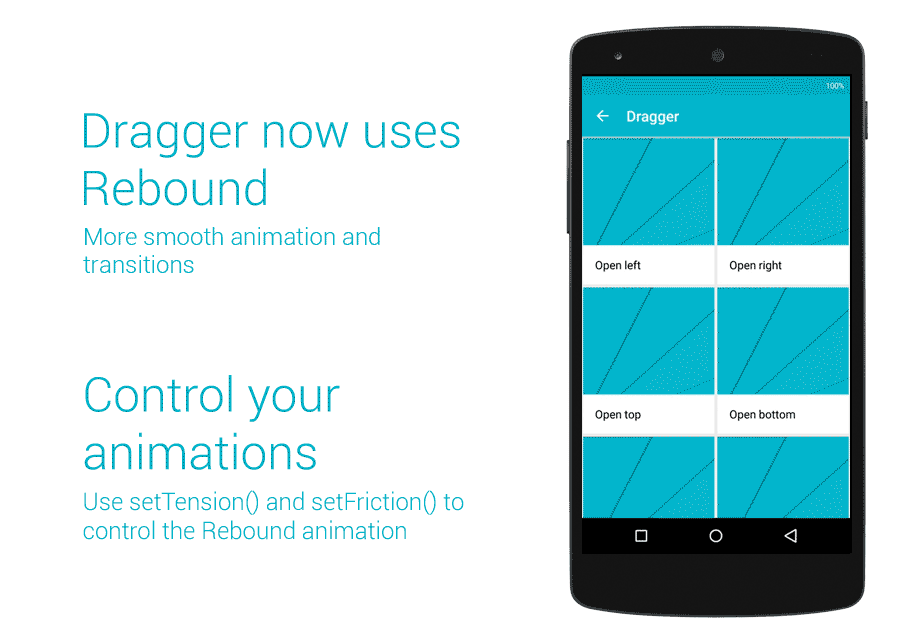This library is not in development anymore, but we are accepting PRs or successors if anyone is interested.
If you want to use these transitions with fragments, take a look at PrismView library!
The library was created in order to provide new animations for activities on Android. Using the ViewDragHelper class, it is possible to create smooth animations that allow full control of the view by the user.
This new component has been created using some concepts described on Flavien Laurent Blog and Denevell Blog.
Dragger now uses Rebound(tiny, 41.7kb) from Facebook to provide more realistic animations and improve performance for old devices.
This library should work on API 10 (but not tested yet).
You can use this library like a view, you just need to do the following:
-
- Add ''DraggerView'' view to your root layout and add two layouts inside it. You can add a shadow view if you want (the first one) and it needs to be invisible.
<com.github.ppamorim.library.DraggerView
android:layout_width="match_parent"
android:layout_height="match_parent"
dragger_layout:drag_view_id="@+id/drag_view"
dragger_layout:shadow_view_id="@+id/shadow_view"
dragger_layout:drag_position="top">
<FrameLayout
android:id="@+id/shadow_view"
android:layout_width="match_parent"
android:layout_height="match_parent"
android:background="@color/transparent"
android:visibility="invisible"/>
<LinearLayout
android:id="@+id/drag_view"
android:layout_width="match_parent"
android:layout_height="match_parent"/>
</com.github.ppamorim.library.DraggerView>In your ''styles'' file, you need a config like this:
<style name="YourTheme" parent="Theme.AppCompat.Light.DarkActionBar">
<item name="android:windowIsTranslucent">true</item>
<item name="android:windowBackground">@android:color/transparent</item>
<item name="android:windowNoTitle">true</item>
<item name="windowActionBar">false</item>
<item name="android:windowAnimationStyle">@null</item>
</style>And your ''manifest'':
<activity
android:name="com.github.dragger.BaseActivity"
android:theme="@style/YourTheme"/>Or, if you need it to be fast:
public class YourActivity extends DraggerActivity {
@Override public void onCreate(Bundle savedInstanceState) {
super.onCreate(savedInstanceState);
setShadowView(R.layout.custom_shadow); // It is not necessary, use if you want.
setContentView(R.layout.layout_content);
}
}Now you can control the slide of the view, just use the method expand() when you want.
Some methods that you can use:
setDraggerCallback(DraggerCallback) //Interface that's provides some infos of the animation.
setSlideEnabled(boolean) //Enable or disable the drag, useful to use with ScrollViews.
setHorizontalDragRange(float) //Draggable distance that the draggableView can use, horizontally.
setVerticalDragRange(float) //Draggable distance that the draggableView can use, vertically.
setRunAnimationOnFinishInflate(boolean) //Run the initial animation, useful if you only want the drag function.
setDraggerLimit(float) //Set the max limit drag, default is 0.5 (center of the screen).
setDraggerPosition(DraggerPosition) //Set the position of archor.
setTension(float) //Tension of the animation. This represent with the friction, how much time the animation will be executed.
setFriction(float) //Friction of the animation. This represent with the tension, how much friction is applied at the tension animation.
show() //Show the drag view with Rebound animation.
closeActivity() //Simply close the activity with Rebound animation, based of the DraggerPosition choosen.
This library use appcompat-v7:23.1.0.
But why not to add in MavenCentral? Because it is so much bureaucratic.
JitPack is there and is the future!
Into your build.gradle:
repositories {
maven {
url "https://jitpack.io"
}
}
dependencies {
implementation 'com.github.ppamorim:dragger:1.2'
}I decided that need to be Out-Of-Box, then... You must use the Android-ObservableScrollView, like this:
dependencies {
implementation 'com.github.ksoichiro:android-observablescrollview:VERSION'
}public void configRecyclerView() {
...
recyclerView.setScrollViewCallbacks(onObservableScrollViewCallbacks);
}
private ObservableScrollViewCallbacks onObservableScrollViewCallbacks =
new ObservableScrollViewCallbacks() {
@Override public void onScrollChanged(int scrollY, boolean firstScroll,
boolean dragging) {
draggerView.setSlideEnabled(scrollY != 0);
}
@Override public void onDownMotionEvent() { }
@Override public void onUpOrCancelMotionEvent(ScrollState scrollState) { }
};This was only possible because Pedro Vicente Gómez Sánchez helped me and I am very grateful for that! Thank you. :) And thank you Facebook for provide Rebound library!
- Pedro Paulo de Amorim - [email protected]

Copyright 2015 Pedro Paulo de Amorim
Licensed under the Apache License, Version 2.0 (the "License");
you may not use this file except in compliance with the License.
You may obtain a copy of the License at
https://www.apache.org/licenses/LICENSE-2.0
Unless required by applicable law or agreed to in writing, software
distributed under the License is distributed on an "AS IS" BASIS,
WITHOUT WARRANTIES OR CONDITIONS OF ANY KIND, either express or implied.
See the License for the specific language governing permissions and
limitations under the License.

